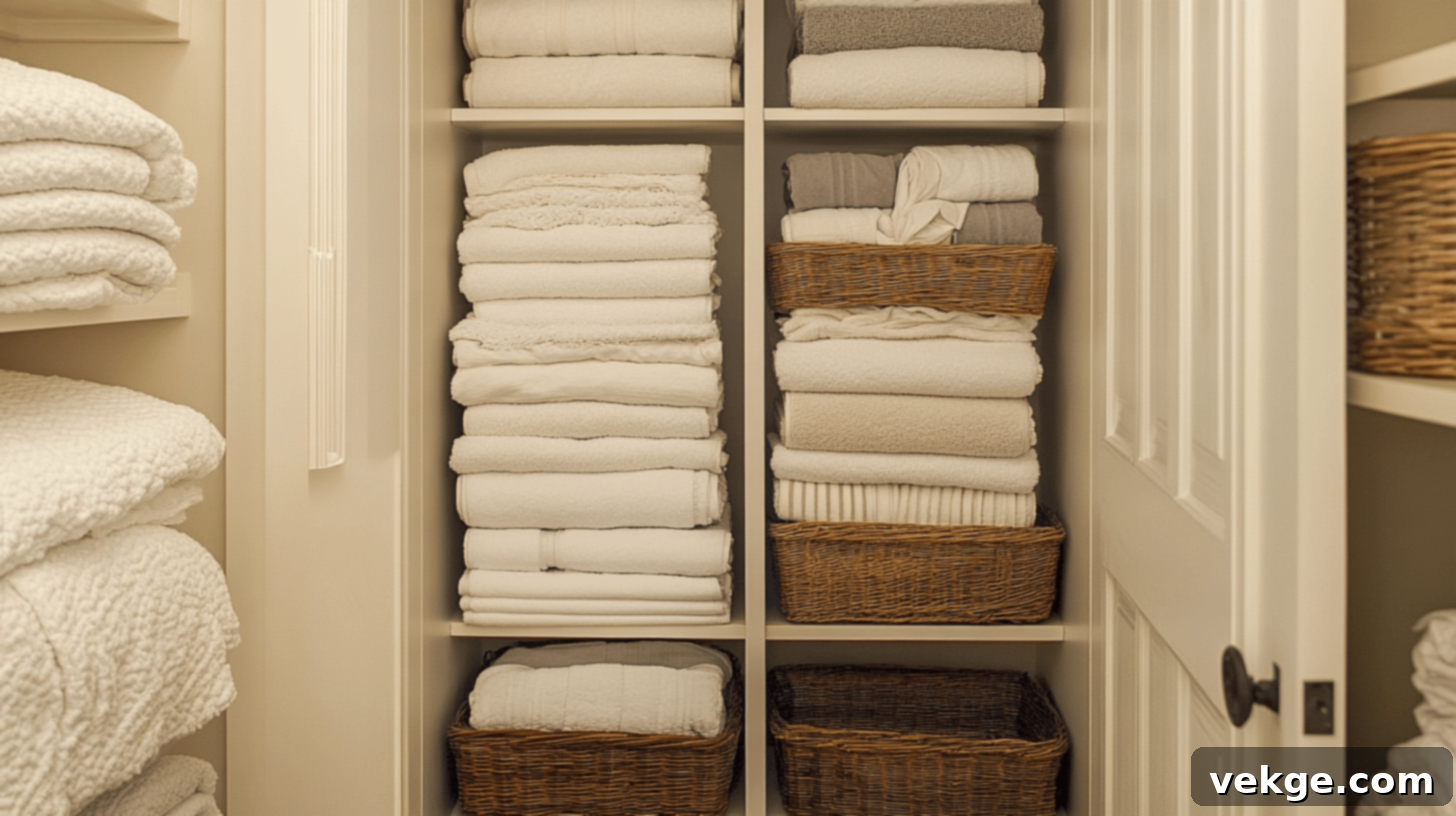The Ultimate Guide to a Perfectly Organized Linen Closet: Declutter, Optimize & Maintain
In any home, a well-organized linen closet is an essential component for maintaining overall tidiness and harmony. When your towels, sheets, and other linens are neatly arranged, it creates a sense of calm and efficiency that can significantly smooth out your daily routine and make life more enjoyable. I’ve personally experienced the transformative power of an efficient linen storage system; it allows me to quickly locate exactly what I need, saving precious time and considerably reducing stress during busy mornings or when preparing for guests.
Beyond the practical benefits, there’s an undeniable satisfaction that comes from opening a tidy linen closet. It adds to your home’s aesthetic appeal and reinforces the feeling of a well-managed space. By maximizing your storage potential, you can keep a greater variety of items without creating clutter, ensuring everything has its rightful place. This guide is designed to help you embark on a rewarding journey to transform your linen closet from a chaotic collection into a model of impeccable organization.
I’ll share a wealth of practical tips and smart strategies I’ve gathered and refined over time, all aimed at helping you create a customized system that works seamlessly for your unique needs and lifestyle. Get ready to bid farewell to frustrating piles and welcome a beautifully organized linen closet that brings both functionality and joy to your home.
Step-by-Step Guide to Organize Your Linen Closet Like a Pro
Achieving a perfectly organized linen closet might seem daunting, but by breaking it down into manageable steps, you’ll find it’s a rewarding process. Follow this comprehensive guide to create a system that truly works.
Step 1: Clear Out and Declutter Everything
The first and most crucial step in any organization project is to start with a clean slate. This allows you to truly assess what you have and what you need.
- Remove All Items: Begin by taking every single item out of your linen closet. This includes all towels, sheets, blankets, toiletries, and any other odds and ends that have accumulated. Placing everything in one spot, like on your bed or the floor, gives you a clear view of the volume you’re dealing with.
- Work in Sections (if needed): For larger or extremely cluttered closets, it can be less overwhelming to tackle one shelf or section at a time. Clear one area, sort it, and then move to the next. This prevents you from feeling swamped by the entire project at once.
- Sort Through Your Linens: This is where the tough decisions happen. Create piles for items to keep, discard, donate, or sell. Be honest with yourself about each item’s value and utility.
- Evaluate Each Item Critically: Before making a decision, consider the condition and usability of each linen.
- Keep: Items that are in good condition, frequently used, and genuinely loved. Ensure they are clean and free of tears or significant stains. For sheet sets, ensure all pieces (fitted sheet, flat sheet, pillowcases) are present.
- Discard: Items that are torn, heavily stained, worn beyond repair, or have lost their absorbency (for towels). These are taking up valuable space and serve no purpose.
- Donate: Linens in good, usable condition but no longer needed or wanted by your household. Many animal shelters also accept old towels and blankets.
- Sell: High-quality, gently used items that could fetch a good price. This might include specialty blankets or nearly new, unused sets.
Step 2: Group Similar Items Together for Efficiency
Once you’ve decluttered, the next step is to categorize your remaining items. Grouping like with like makes finding what you need incredibly easy and helps streamline the storage process.
- Categorize Your Items: Begin by creating logical categories for your linens and other closet inhabitants. Common groupings include:
- Bed Linens: Separate by bed size (twin, full, queen, king) and then by set (sheets, pillowcases). Consider folding complete sheet sets and tucking the fitted and flat sheets into one of their matching pillowcases to keep them together.
- Towels: Group by type (bath towels, hand towels, washcloths) and perhaps by user or color if that suits your system. Keep guest towels separate if you have them.
- Hair Products & Toiletries: Group shampoo, conditioner, body wash, lotions, and other personal care items. Ensure they are in sealed containers to prevent spills.
- First Aid & Medicine: Keep these together and clearly labeled, away from general toiletries.
- Cleaning Supplies: If your linen closet doubles as a utility closet, group cleaning cloths, sprays, and spare sponges together.
- Ensure Easy Access for Sets: For items like sheets and pillowcases, keeping them together is paramount. The “pillowcase trick” (folding the set and tucking it into one pillowcase) is a game-changer for maintaining order and easy retrieval.
Step 3: Measure the Closet Space Accurately
Before you even think about buying storage solutions, accurate measurements are your best friend. This step ensures that any organizing products you purchase will fit perfectly, preventing frustrating returns and wasted money.
- Measure All Dimensions: Use a tape measure to get the precise length, width, and height of your entire closet. Don’t forget to measure the depth of each shelf, the height between shelves, and the available space on the back of the door.
- Importance for Purchasing: These measurements are critical for selecting bins, baskets, shelf dividers, or over-the-door organizers. Knowing your exact space prevents buying items that are too large or too small, ensuring optimal use of every inch.
Step 4: Assess and Optimize Storage Solutions
With your measurements in hand, it’s time to choose the right tools to maximize your space and keep things tidy. Think about both functionality and aesthetics.
- Assess Available Space: Based on your measurements and the categories of items you have, consider how much space each category needs and what types of organizing products will best serve those needs.
- Choose Organizing Solutions Wisely:
- Soft Fabric Bins: Ideal for delicate items, small towels, or extra washcloths. They are flexible and can often be folded away when not in use.
- Plastic Storage Bins (Clear Recommended): Perfect for toiletries, cleaning supplies, or items you want to see at a glance. Clear bins make it easy to identify contents without pulling everything out.
- Wicker or Decorative Baskets: Excellent for adding a touch of style while holding larger items like extra blankets or guest towels. They can also hide items you don’t want visible.
- Hooks: Install hooks on the inside of the closet door or walls for robes, often-used towels, or laundry bags.
- Shelf Dividers: These are fantastic for keeping stacks of towels or linens upright and preventing them from toppling over, creating neater, more defined sections.
- Shelf Risers/Expanders: Double your shelf space by adding risers for smaller items or using expanders to create new levels within existing shelves.
Step 5: Utilize Vertical Space to Its Full Potential
Many linen closets have untapped vertical potential. Looking beyond the shelves can unlock significant extra storage capacity, especially in smaller spaces.
- Make Use of Closet Walls and Doors: Don’t overlook these surfaces. They are prime real estate for additional storage.
- Add Door Racks or Hanging Organizers:
- Over-the-Door Organizers: These are perfect for smaller, lighter items like hair care products, lotions, dental floss, or even rolled washcloths. Look for ones with clear pockets or multiple shelves.
- Hanging Shoe Organizers (Modified): The pockets can be repurposed to hold small cleaning supplies, spare light bulbs, or individual toiletries.
- Wall-Mounted Shelves or Baskets: If your closet walls are sturdy, consider adding slim shelves or small wire baskets for less frequently used items or decorative elements.
- Efficiently Use Every Inch: Think creatively about how to stack, hang, and store. For example, use tension rods to create mini-shelves or hang items between existing shelves.
Step 6: Organize by Frequency of Use for Optimal Access
Once you have your storage solutions in place, arrange your items strategically based on how often you reach for them. This optimizes accessibility and keeps frequently used items within easy reach.
- Place Frequently Used Items at Eye Level: This “prime real estate” should be reserved for items you access daily or weekly, such as everyday bath towels, current sheet sets, and frequently used toiletries. This saves time and prevents rummaging.
- Store Less-Used Items Higher Up or at the Bottom:
- Top Shelves: Ideal for seasonal items like holiday tablecloths, extra blankets, or guest linens that are only used a few times a year. Keep these in labeled bins for easy identification.
- Bottom Shelves/Floor: Good for bulkier items like laundry detergent, extra toilet paper rolls, or heavier blankets. Ensure items on the bottom are in sturdy containers or off the floor if there’s a risk of moisture.
- Arrange by Usage Pattern: Think about your household’s rhythm. If you have children, place their towels and bedding at a height they can easily reach themselves, fostering independence.
Step 7: Label Everything for Lasting Organization
Labeling is the unsung hero of long-term organization. It ensures everyone in the household knows where things belong and helps maintain the system you’ve so carefully created.
- Label All Bins and Baskets: Clear, concise labels are key. Whether it’s “Queen Sheets,” “Bath Towels,” “Guest Soaps,” or “Cleaning Supplies,” labels eliminate guesswork and make putting items away as easy as taking them out.
- Choose Your Labeling Method:
- Handwritten Labels: Simple, quick, and can be changed easily. Use cardstock and tie them to baskets, or use strong tape on bins.
- Label Makers: Provide a clean, professional, and consistent look. Ideal for a more polished aesthetic.
- Chalkboard Labels: Offer flexibility as they can be wiped clean and re-labeled as contents change.
- Labels Maintain Organization: This step is vital for making your organized linen closet sustainable. When everyone knows where an item goes, it’s much more likely to be returned to its proper spot, preventing clutter from creeping back in. Labels are especially important in shared living spaces.
How to Organize a Linen Closet on a Budget
Who says you need to spend a fortune on fancy organizers to create a stunning, functional linen closet? Let’s explore some ingenious, wallet-friendly ways to whip your closet into shape using items you might already have around the house or can acquire cheaply.
Repurpose with Purpose: Creative Solutions from Everyday Items
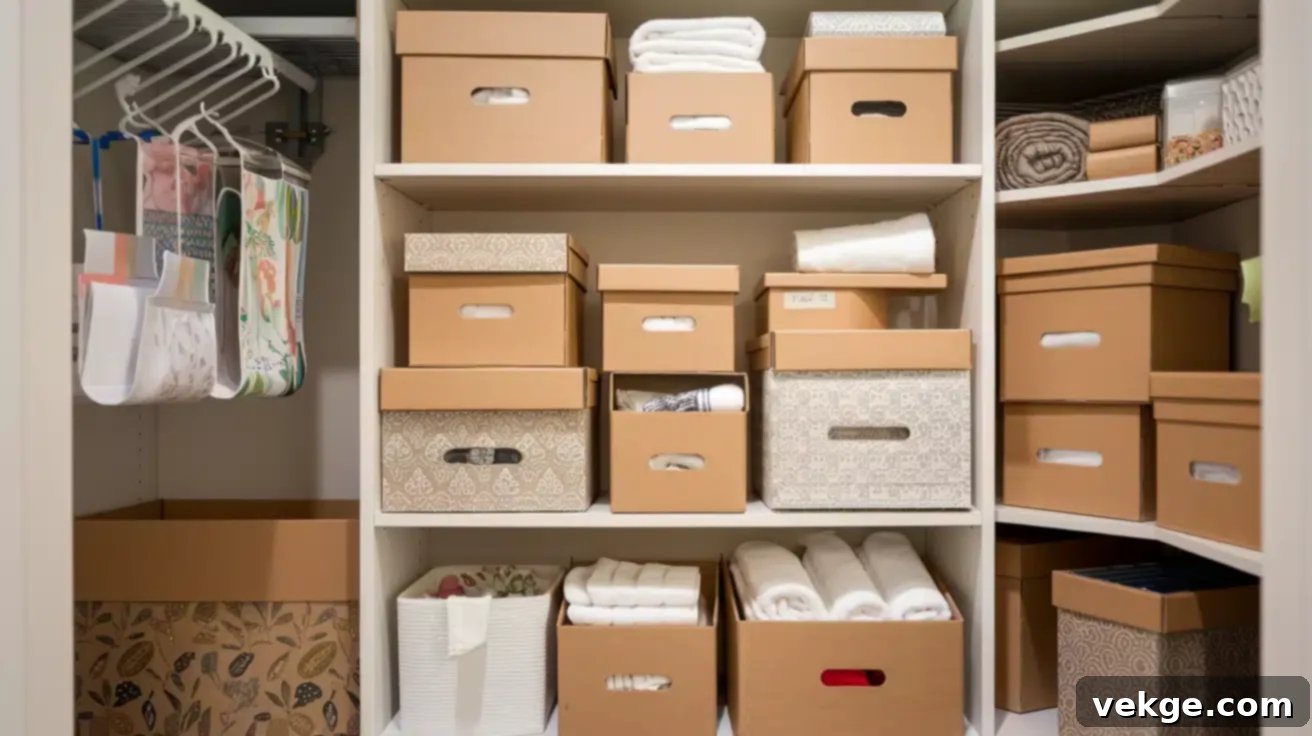
- Cardboard Box Bonanza: Don’t toss those old cereal or shoe boxes! They can be transformed into chic, sturdy organizers. Simply cover them with attractive wrapping paper, contact paper, or even leftover fabric scraps to match your decor. Use these DIY bins to neatly separate smaller items like washcloths, hand towels, or even individual toiletries. They are fantastic for keeping small collections contained and visible.
- Tension Rod Magic: Spare tension rods are incredibly versatile. Install them horizontally to create vertical dividers for rolled towels, preventing them from toppling over. You can also hang small, lightweight baskets or S-hooks from them to store cleaning sprays or other items, effectively maximizing every inch of vertical space beneath a shelf. They’re perfect for adding an extra “shelf” for small items.
- Hanger Helpers: Repurpose old pants hangers, especially those with clips, to keep entire sheet sets together. Clip the folded sheet set (including pillowcases) onto the hanger, and then hang it on a rod. This method keeps sets unified, prevents wrinkles, and saves valuable shelf space. You can also use them to hang tablecloths, runners, or even scarves to keep them wrinkle-free and easily accessible.
DIY Delights: Crafting Your Way to a Tidy Closet
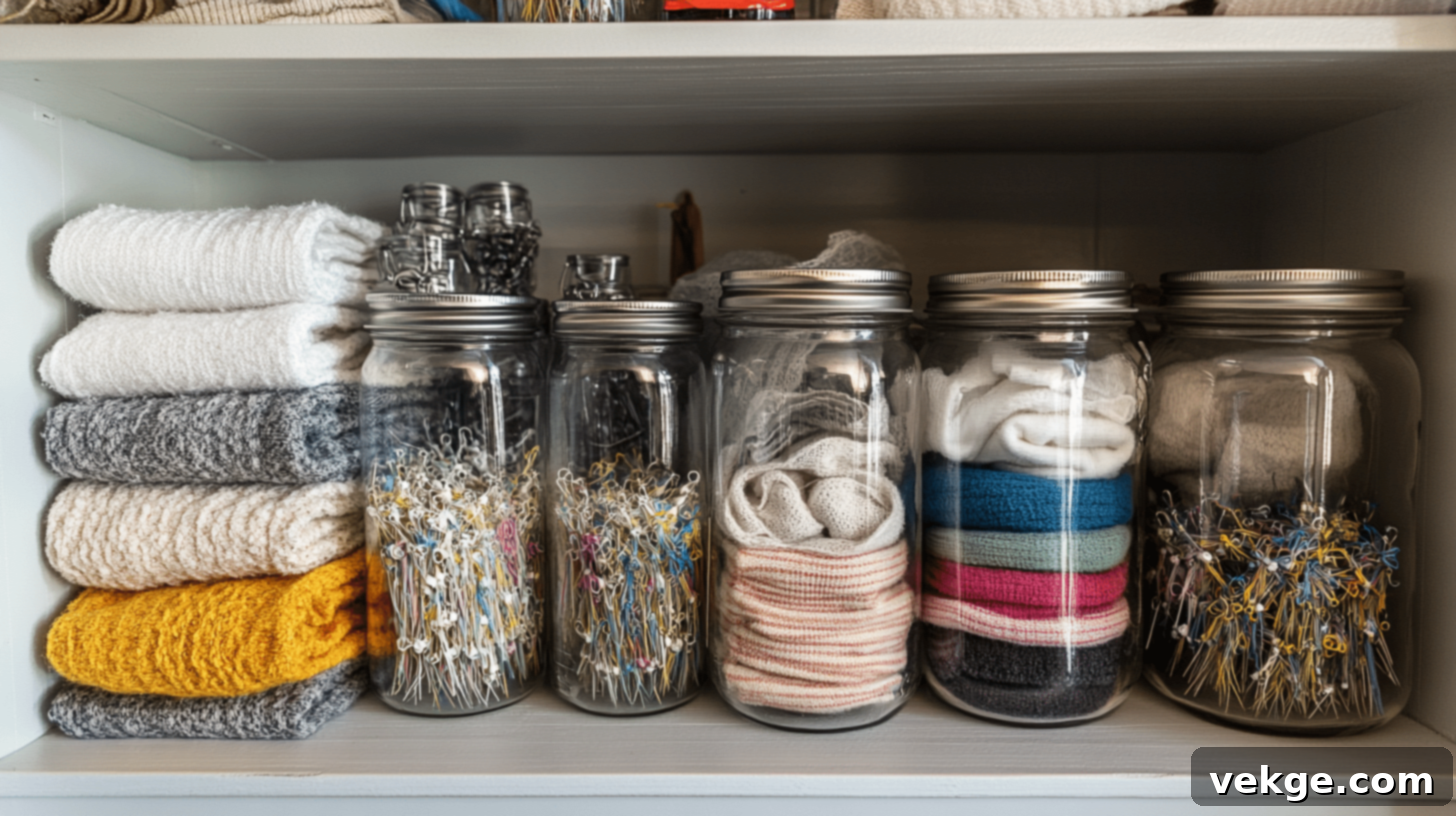
- No-Sew Fabric Bins: Unleash your inner crafter! Old pillowcases, sturdy fabric scraps, or even worn-out jeans can be refashioned into soft storage bins without a single stitch. Simply fold and shape them, or use fabric glue to create more structured boxes. These are perfect for delicate items like lingerie bags or small hand towels. For extra storage, get creative by making hanging organizers with rope and hot glue – ideal for small, frequently used items that you want to keep off shelves.
- Mason Jar Marvels: Those leftover mason jars aren’t just for canning. They are excellent for storing small items that often get lost in larger bins, such as safety pins, buttons, cotton balls, Q-tips, or hair ties. For an added touch of freshness, fill some jars with dried lavender, potpourri, or cedar chips to create homemade sachets that will keep your linens smelling wonderful and fresh.
- Shower Curtain Ring Wonders: Simple shower curtain rings can be incredibly useful. Loop them through towels to create easy-to-hang storage on a tension rod or hook, making them accessible and visible. You can also use them to create a clever scarf organizer or to hang lightweight throws, freeing up valuable shelf space and keeping these items neatly separated.
Budget-Friendly Buys: Smart Shopping for Storage Solutions
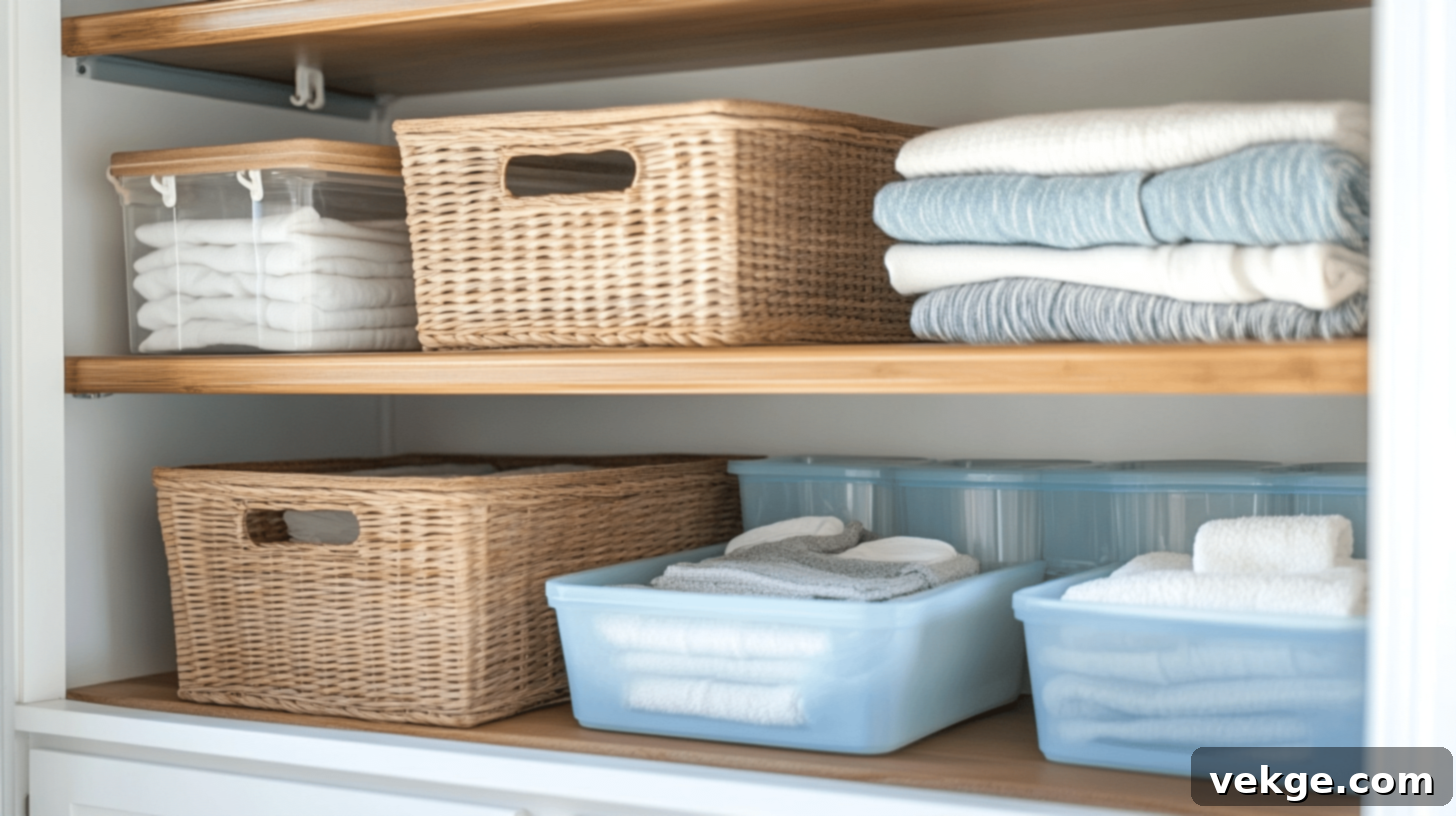
- Dollar Store Gems: Don’t underestimate the power of your local dollar store or discount retailer. You can find an array of budget-friendly plastic bins, small baskets, and adhesive hooks that can significantly boost your closet’s functionality. Look for plastic caddies for toiletries, small bins for categorizing items, and non-slip shelf liners to keep things from sliding around.
- Thrift Store Treasures: Thrift stores, flea markets, and second-hand shops are treasure troves for unique and affordable storage options. Vintage suitcases can be a stylish and discreet way to store out-of-season linens or items you don’t access frequently. Old wooden crates can be stacked or placed individually to add a rustic-chic touch to your closet while offering sturdy storage for towels or folded blankets. Look for sturdy magazine files or old file holders for storing folded pillowcases or small tablecloths vertically.
Remember, organizing on a budget is fundamentally about creativity, resourcefulness, and seeing the potential in everyday items. With these tips, you can achieve a beautifully organized linen closet that looks fantastic and functions perfectly, all without breaking the bank.
Keeping Your Linen Closet Tidy: Easy Maintenance Tips
An organized linen closet isn’t a one-time project; it’s a system that benefits from ongoing, minimal effort. Regular maintenance ensures your hard work pays off and keeps your space functional and beautiful over time.
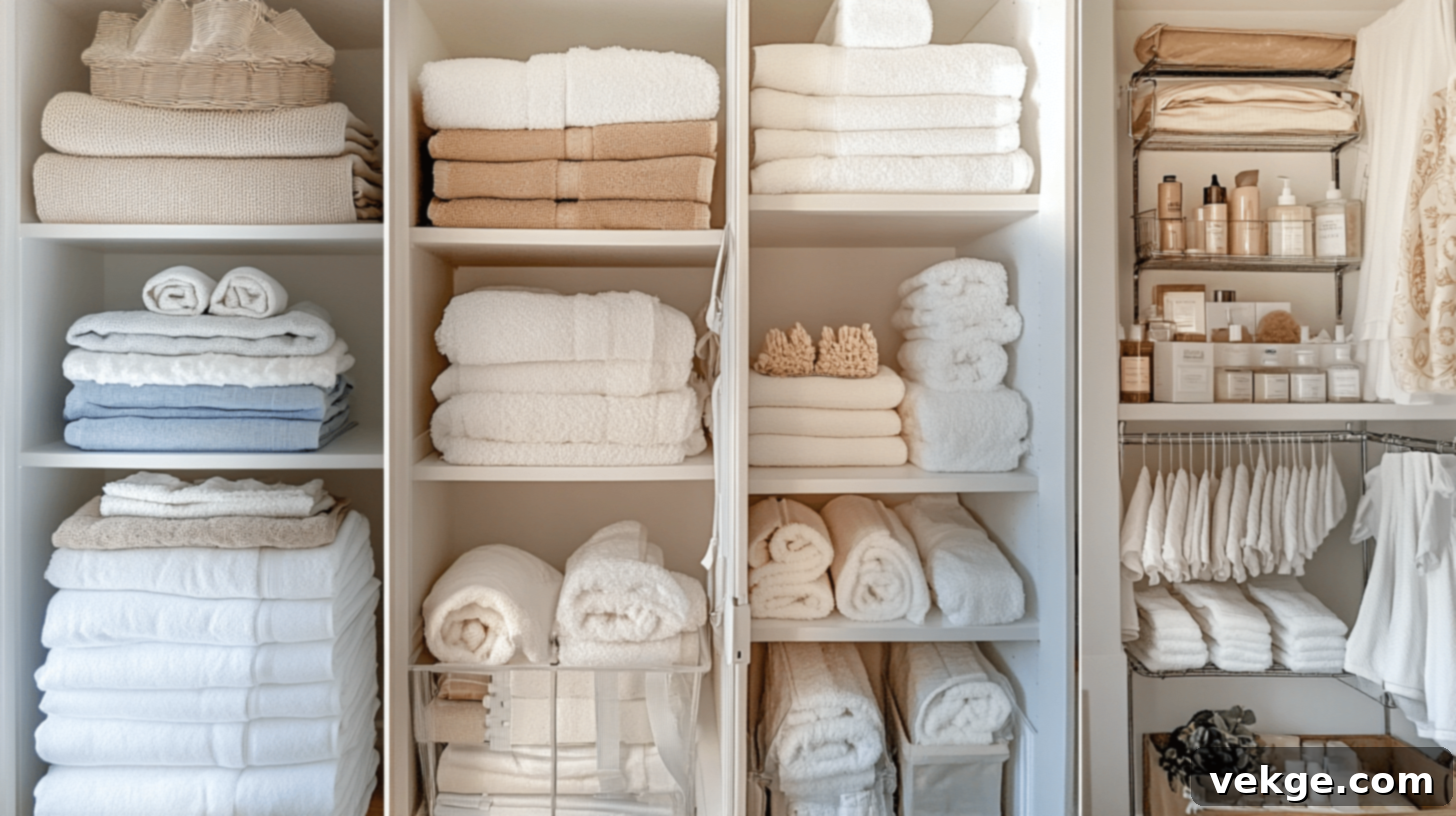
- Weekly Quick Tidy: Dedicate a mere 5-10 minutes each week to a quick “reset.” This involves straightening any messy piles, returning misplaced items to their designated spots, and a quick wipe-down of shelves if dust has accumulated. This small effort prevents major clean-ups later.
- Rotate Your Linens: Every month or two, practice a simple rotation method. Move items from the bottom of stacks to the top (first in, first out). This ensures that all your linens get even wear and tear, and it prevents musty odors from developing in rarely-used items. It also helps to air out linens that might have been stored for a while.
- One In, One Out Rule: To prevent your closet from slowly accumulating excess items, adopt the “one in, one out” rule. When you purchase new linens (a new sheet set, for example), commit to removing an old or worn-out item. This simple discipline prevents overcrowding and maintains the integrity of your organizational system.
- Seasonal Check-Up: Twice a year, perhaps during spring cleaning and before the winter holidays, conduct a more thorough review. Evaluate all your linens for wear and tear, donate any unused or unwanted items, and clean all your organizers. This seasonal refresh keeps your closet current, functional, and ready for changing needs.
- Refresh Your Scent Solutions: Scent sachets, cedar blocks, or essential oil diffusers can lose their potency over time. Every few months, replace or refresh them to ensure your closet continues to smell fresh and clean. A pleasant scent makes opening your linen closet a more enjoyable experience.
- Label Check: Periodically, take a moment to ensure that all your labels are still clear, legible, and firmly in place. If your organization system has evolved or items have shifted, update any labels as needed. Clear labeling remains a fundamental key to maintaining order, especially in households where multiple people access the closet.
- Reassess Regularly: Your family’s needs and your home’s inventory can change. Every six months to a year, take a step back and evaluate whether your current system is still working effectively. Are there new items? Are old categories still relevant? Adjust your system as needed to ensure your linen closet remains efficient, convenient, and perfectly suited to your lifestyle.
Product Recommendations for a Dream Linen Closet
While creativity and DIY solutions can go a long way, sometimes a few targeted product purchases can elevate your linen closet organization to the next level. These recommendations are designed to help you efficiently store, protect, and beautify your linens, making your closet both functional and stylish.
1. BALEINE 4 Pack Fabric Storage Bins
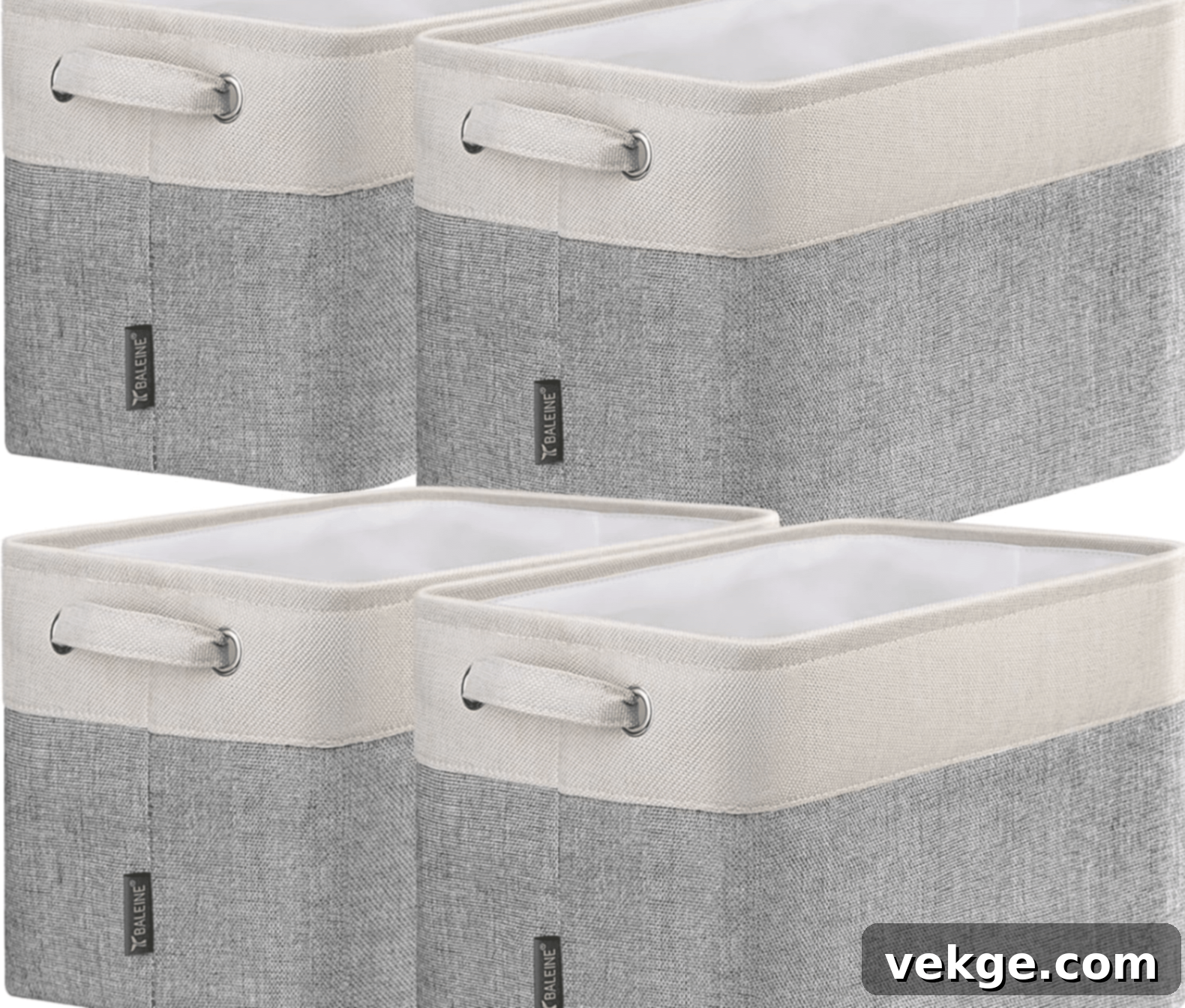
Elevate your home organization with these durable linen storage baskets. Featuring sturdy handles for easy transport, a versatile 15″x11″x9.5″ size, and a sleek design, these bins offer both style and functionality for any room. Perfect for neatly tucking away towels, sheets, or seasonal items, they are backed by BALEINE’s 30-day money-back guarantee for peace of mind.
Available Colors: Black, Brown, Grey, Navy Blue
2. Fab totes 6 Pack Clothes Storage Containers
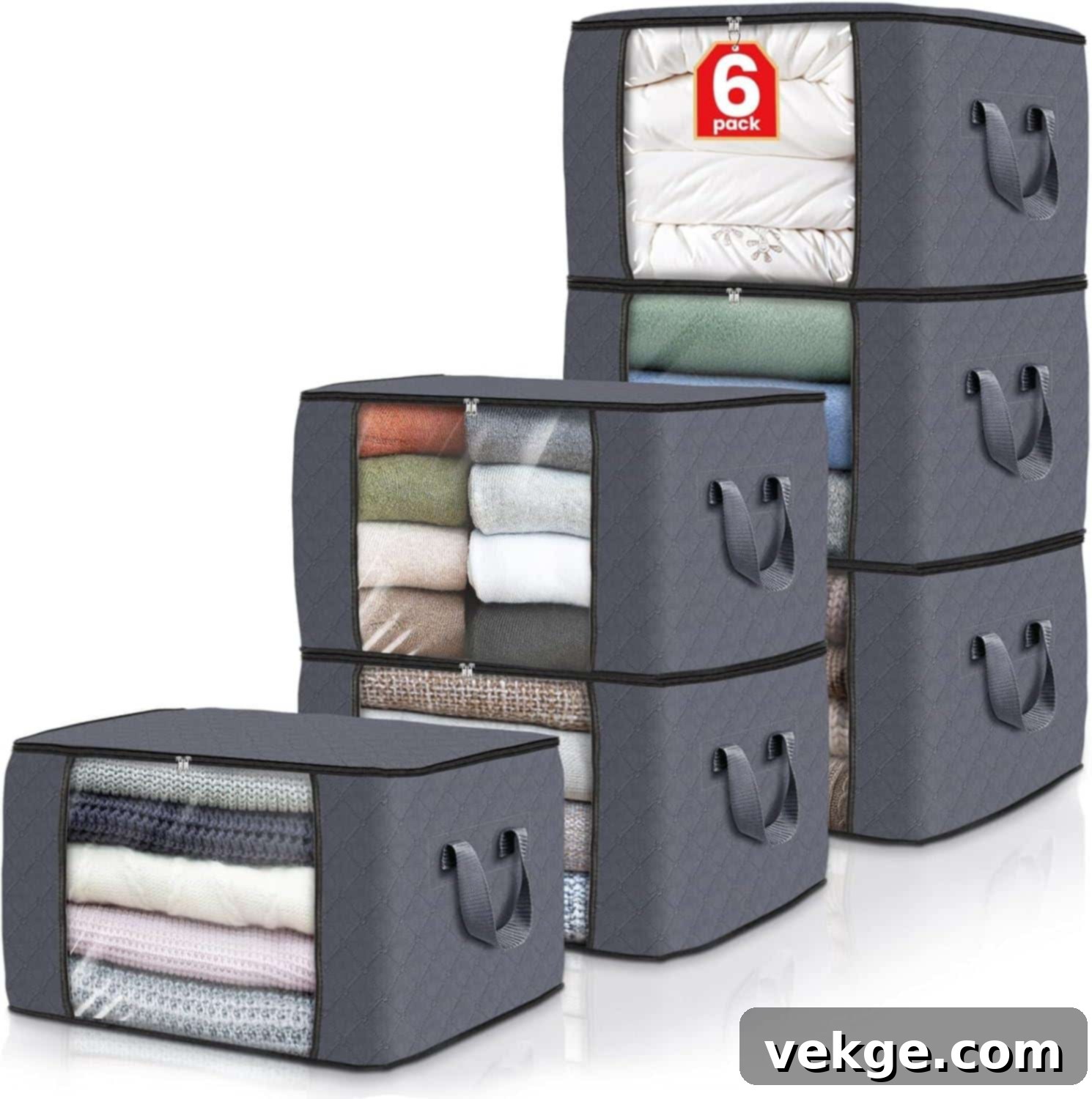
These versatile storage bags are perfect for larger or seasonal linens like comforters, extra blankets, or off-season clothing. They feature reinforced handles for easy lifting, convenient see-through windows for quick identification of contents, and sturdy zippers to keep items dust-free. Made of durable non-woven fabric and PVC, they’re flexible, stackable, and suitable for various uses from bedroom storage to dorm rooms or even garage organization.
Available Colors: Black, Blue, Grey, Green
3. Space Saving Hangers for Clothes
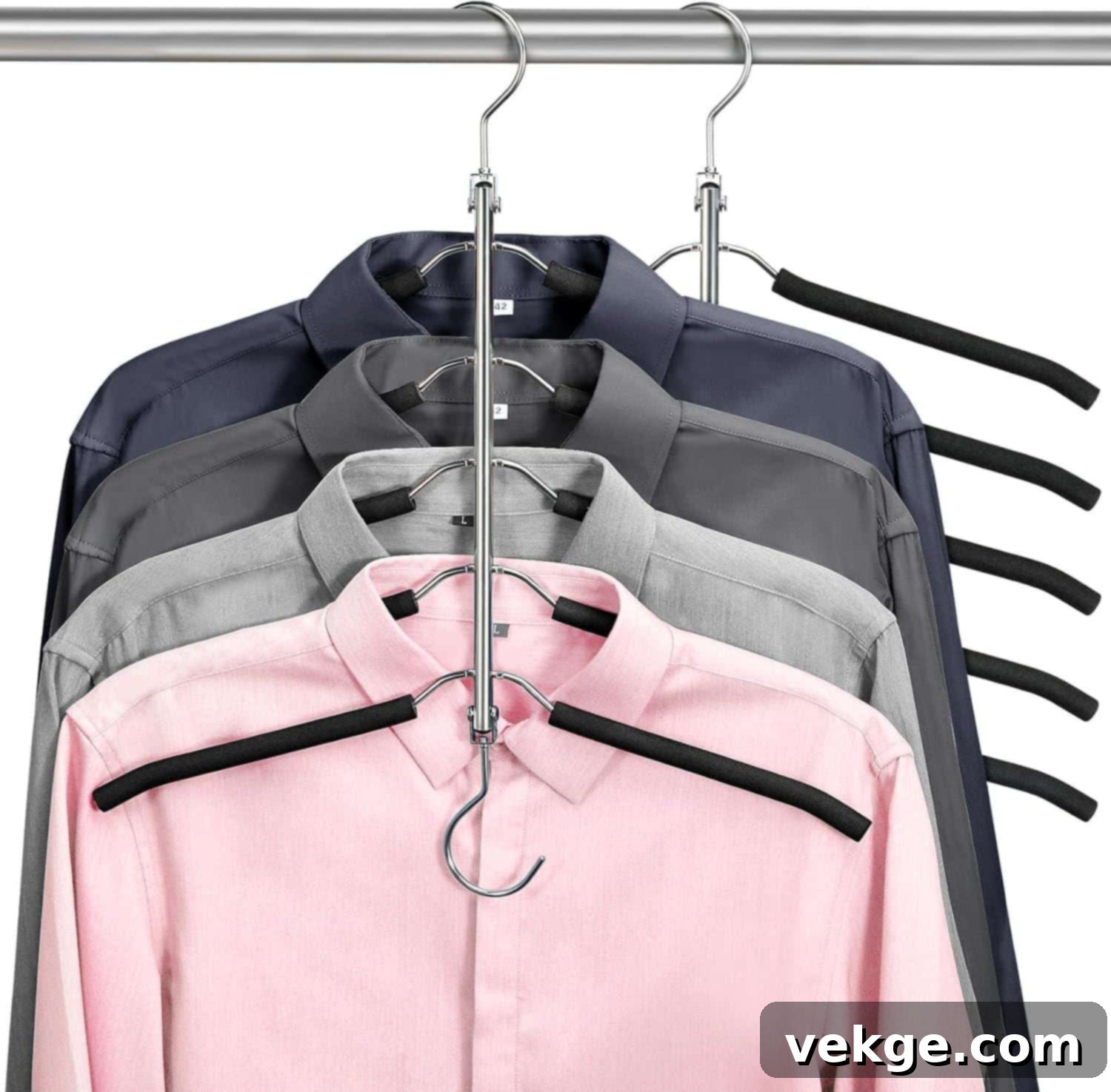
These innovative space-saving hangers are a fantastic solution for maximizing hanging space in your linen closet, especially for items like tablecloths, robes, or even multiple sets of guest towels. Featuring a 5-tier design, they can free up to 80% of your closet space. Crafted from sturdy stainless steel with non-slip EVA foam arms, they offer versatile 360° swivel hooks and can hold up to 30 pounds, making wardrobe and linen closet organization effortless and efficient.
4. Yecaye 4 Pack Bed Sheet Organizer, Foldable Linen Closet Organizers
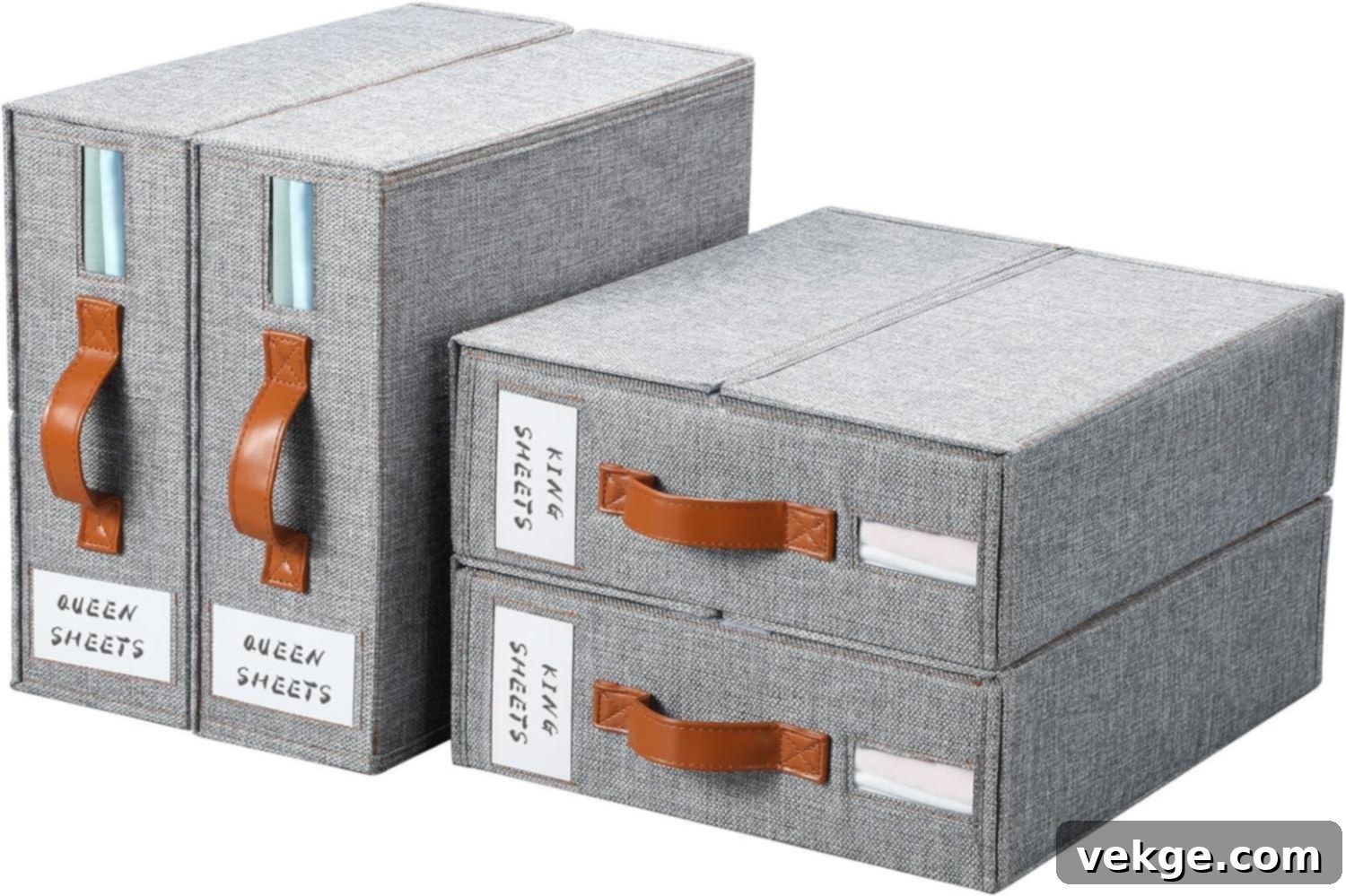
This bedding organizer set is a dream come true for keeping sheet sets perfectly contained and easily identifiable. Each organizer features a foldable design with a clear window and label cards, allowing you to quickly see and identify the contents without disturbing neatly folded stacks. Made of sturdy linen fabric with elegant PU leather handles, it measures 15″x13″x4.3″, making it perfect for storing queen/king size sheets and keeping your linen closet tidy, dust-free, and beautifully organized.
Available Colors: Grey, Beige
Integrating a mix of these purposeful products with your DIY and repurposed solutions will create a highly efficient and aesthetically pleasing linen closet that works perfectly for your home.
Conclusion: Embrace the Calm of an Organized Linen Closet
I sincerely hope this comprehensive guide has illuminated the path to a beautifully organized linen closet, demonstrating that it can be both a simple and incredibly rewarding endeavor, even on a budget. By diligently following these steps – from the initial thorough emptying and sorting, to implementing creative DIY solutions, and committing to consistent maintenance – you are well on your way to creating a space that is not only highly functional but also a true pleasure to behold.
Remember, the ultimate goal is to discover and implement a system that truly resonates with you and your family’s unique needs and habits. Don’t feel pressured to achieve perfection overnight; start small, celebrate incremental progress, and stay consistent with your efforts. Most importantly, don’t be afraid to adjust and refine your system as your needs evolve over time. Flexibility is key to lasting organization.
I am genuinely confident that your newly organized linen closet will become a source of daily relief, saving you valuable time and significantly reducing stress in your everyday life. The calm and efficiency it brings will ripple through your entire home.
I’d absolutely love to hear about your personal linen closet transformation journey! Have you tried any of these tips and found them particularly effective? Do you have your own brilliant organizing hacks or budget-friendly solutions to share with our community? Please feel free to leave a comment below or even share your amazing before-and-after photos. Let’s inspire each other to create more organized, peaceful, and truly enjoyable homes!
Frequently Asked Questions About Linen Closet Organization
How Do I Prevent Linens from Smelling Musty?
Preventing musty odors is crucial for maintaining fresh linens. First and foremost, ensure that all items are completely dry before being put away; even slightly damp linens can develop mold and a musty smell. Second, promote good air circulation within your closet; avoid overstuffing shelves, which can trap moisture. Consider using moisture absorbers like silica gel packets or a small container of baking soda to draw out dampness. Additionally, natural fresheners such as scented sachets filled with lavender or cedar blocks can imbue your linens with a pleasant aroma. Regularly opening the closet door for a few minutes can also help with air exchange.
What is the Best Way to Store Extra Pillows and Bulky Items?
Bulky items like extra pillows, duvets, and large blankets can quickly consume valuable closet space. The most effective method is to use vacuum storage bags. These bags compress items dramatically, reducing their volume by up to 80% and also protecting them from dust, moisture, and pests. Once vacuum-sealed, store these compressed bags on top shelves or at the very bottom of the closet. For items used more frequently, consider clear, labeled containers or large fabric bins that can be stacked. If closet space is extremely limited, under-bed storage containers are an excellent alternative for rarely used or seasonal bulky items, keeping them out of sight but still accessible when needed.
How Many Towel and Sheet Sets Should I Keep?
The ideal number of towel and sheet sets depends on your household size, laundry frequency, and lifestyle. A good general guideline is to keep 2-3 sets of sheets per bed in regular use. This allows one set on the bed, one in the laundry, and one clean set ready for rotation. For guests, 1-2 extra sets are usually sufficient, depending on how often you host. For towels, aim for 3-4 sets per person in the household (a set typically includes a bath towel, hand towel, and washcloth). This provides enough for daily use, laundry cycles, and a few spares for emergencies or additional guests. Adjust these numbers based on how often you do laundry (more frequent laundry means you can keep fewer sets) and how many unexpected visitors you typically accommodate.
How Do I Organize a Small or Narrow Linen Closet?
Organizing a small or narrow linen closet requires maximizing every available inch and adopting smart storage techniques.
- Prioritize Purging: Be extra ruthless with decluttering in a small space. Only keep what you truly need and use.
- Utilize Vertical Space: Install additional slim shelves if possible, or use shelf risers to create more layers within existing shelves.
- Door-Mounted Organizers: Over-the-door racks with multiple pockets or shelves are invaluable for small items like toiletries, cleaning supplies, or rolled hand towels.
- Roll Instead of Fold: Rolling towels and sheets can often save space compared to traditional folding, and it makes items easier to grab without disturbing the whole stack.
- Slim, Stackable Containers: Opt for narrow, stackable bins and baskets that fit snugly into your limited shelf depth. Clear containers are beneficial here for visibility.
- Sheet Set Solution: Store entire sheet sets inside one of their pillowcases to keep them neatly bundled and prevent them from unraveling.
- Tension Rod Tricks: Use small tension rods to create mini hanging spaces for spray bottles or to vertically divide rolled items.
Every decision in a small closet should be made with efficiency and space-saving in mind.
